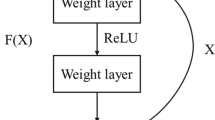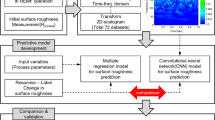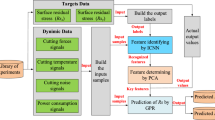Abstract
Surface roughness is widely used for product quality assessment due to its ability to accurately portray the fatigue strength, wear resistance, surface hardness, and other properties of a product. In this paper, a spatiotemporal adaptive ensemble prediction method (STAEP) was proposed through the combination of static cutting parameters and dynamic vibration signals. We firstly performed envelope analysis of the vibration signal for the amplitude modulation phenomenon of vibration measurement and extracted the surface roughness features of the signal envelope. Meanwhile, the complete ensemble empirical mode decomposition with adaptive noise (CEEMDAN) was also performed to decompose the complex vibration signal into intrinsic mode functions of different frequency ranges. Then, the features contained in the processed vibration signal were extracted by statistics and one-dimensional convolutional neural network (1D-CNN), respectively. The extracted features were fused via a hybrid feature selection method based on Pearson correlation coefficient and random forest. Finally, the highly correlated features were fed into the spatiotemporal adaptive support vector regression and bi-directional gated recurrent unit for surface roughness ensemble prediction. In this paper, surface roughness prediction experiments were conducted on the open-source dataset S45C and GAMHE 5.0. In comparison with the results of the latest methods, the proposed model has the highest prediction accuracy on both datasets, and the mean absolute percentage error on the test set is reduced by 5.4395% on average compared to the best comparison method. Moreover, ablation experiments were conducted to verify the effectiveness of the proposed model and its components.














Similar content being viewed by others
References
Benardos PG, Vosniakos G-C (2003) Predicting surface roughness in machining: a review. Int J Mach Tools Manuf 43(8):833–844. https://doi.org/10.1016/S0890-6955(03)00059-2
Abbas AT, Yu Pimenov D, Erdakov IN, Mikolajczyk T, El Danaf EA, Taha MA (2017) Minimization of turning time for high-strength steel with a given surface roughness using the Edgeworth-Pareto optimization method. Int J Adv Manuf Technol 93(5):2375–2392. https://doi.org/10.1007/s00170-017-0678-2
Abouelatta OB, Madl J (2001) Surface roughness prediction based on cutting parameters and tool vibrations in turning operations. J Mater Process Technol 118(1–3):269–277. https://doi.org/10.1016/S0924-0136(01)00959-1
Ahmad MS, Adnan SM, Zaidi S, Bhargava P (2020) A novel support vector regression (SVR) model for the prediction of splice strength of the unconfined beam specimens. Constr Building Mater 248:118475. https://doi.org/10.1016/j.conbuildmat.2020.118475
Schreiber M, Klöber-Koch J, Bömelburg-Zacharias J, Braunreuther S, Reinhart G (2019) Automated quality assurance as an intelligent cloud service using machine learning. Procedia CIRP 86:185–191. https://doi.org/10.1016/j.procir.2020.01.034
Pan Y, Kang R, Dong Z, Du W, Yin S Bao Y (2020) On-line prediction of ultrasonic elliptical vibration cutting surface roughness of tungsten heavy alloy based on deep learning. J Intell Manuf. 1–11. https://doi.org/10.1007/s10845-020-01669-9
Ibrahim Etem Saklakoglu and Sefika Kasman (2011) Investigation of micro-milling process parameters for surface roughness and milling depth. The International Journal of Advanced Manufacturing Technology 54(5):567–578. https://doi.org/10.1007/s00170-010-2953-3
Chang C-K, Lu HS (2006) Study on the prediction model of surface roughness for side milling operations. Int J Adv Manuf Technol 29(9):867–878. https://doi.org/10.1007/s00170-005-2604-2
Yuan Y, Jing X, Ehmann KF, Zhang D (2018) Surface roughness modeling in micro end-milling. Int J Adv Manuf Technol 95(5):1655–1664. https://doi.org/10.1007/s00170-017-1278-x
Li L, An Q (2016) An in-depth study of tool wear monitoring technique based on image segmentation and texture analysis. Measurement 79:44–52. https://doi.org/10.1016/j.measurement.2015.10.029
Ghodrati S, Kandi SG, Mohseni M (2018) Nondestructive, fast, and cost-effective image processing method for roughness measurement of randomly rough metallic surfaces. JOSA A 35(6):998–1013. https://doi.org/10.1364/JOSAA.35.000998
Shahabi HH, Ratnam MM (2016) Simulation and measurement of surface roughness via grey scale image of tool in finish turning. Precis Eng 43:146–153. https://doi.org/10.1016/j.precisioneng.2015.07.004
García Plaza E, Núñez López PJ (2017) Surface roughness monitoring by singular spectrum analysis of vibration signals. Mech Syst Signal Process 84:516–530. https://doi.org/10.1016/j.ymssp.2016.06.039
Elangovan M, Sakthivel NR, Saravanamurugan S, Nair BB, Sugumaran V (2015) Machine learning approach to the prediction of surface roughness using statistical features of vibration signal acquired in turning. Procedia Comp Sci 50:282–288. https://doi.org/10.1016/j.procs.2015.04.047
Chen C-C, Liu N-M, Chiang K-T, Chen H-L (2012) Experimental investigation of tool vibration and surface roughness in the precision end-milling process using the singular spectrum analysis. Int J Adv Manuf Technol 63(5):797–815. https://doi.org/10.1007/s00170-012-3943-4
E Daniel Kirby, Joseph C Chen and Julie Z Zhang. Development of a fuzzy-nets-based in-process surface roughness adaptive control system in turning operations. Expert Systems with Applications. 2006;30(4):592–604. https://doi.org/10.1016/j.eswa.2005.07.005.
Ghani AK, Choudhury IA (2002) Study of tool life, surface roughness and vibration in machining nodular cast iron with ceramic tool. J Mater Process Technol 127(1):17–22. https://doi.org/10.1016/S0924-0136(02)00092-4
Risbood KA, Dixit US, Sahasrabudhe AD (2003) Prediction of surface roughness and dimensional deviation by measuring cutting forces and vibrations in turning process. J Mater Process Technol 132(1–3):203–214. https://doi.org/10.1016/S0924-0136(02)00920-2
García Plaza E, Núñez López PJ (2018) Application of the wavelet packet transform to vibration signals for surface roughness monitoring in CNC turning operations. Mech Syst Signal Process 98:902–919. https://doi.org/10.1016/j.ymssp.2017.05.028
Khorasani AmirMahyar, Yazdi MRS (2017) Development of a dynamic surface roughness monitoring system based on artificial neural networks (ANN) in milling operation. The International Journal of Advanced Manufacturing Technology 93(1):141–151. https://doi.org/10.1007/s00170-015-7922-4
Wu TY, Lei KW (2019) Prediction of surface roughness in milling process using vibration signal analysis and artificial neural network. Int J Adv Manuf Technol 102(1):305–314. https://doi.org/10.1007/s00170-018-3176-2
Abdeljaber O, Avci O, Kiranyaz S, Gabbouj M, Inman DJ (2017) Real-time vibration-based structural damage detection using one-dimensional convolutional neural networks. J Sound Vib 388:154–170. https://doi.org/10.1016/j.jsv.2016.10.043
Achmad P Rifai, Hideki Aoyama, Nguyen Huu Tho, Siti Zawiah Md Dawal and Nur Aini Masruroh. Evaluation of turned and milled surfaces roughness using convolutional neural network. Measurement. 2020;161:107860. https://doi.org/10.1016/j.measurement.2020.107860.
Lin W-J, Lo S-H, Young H-T, Hung C-L (2019) Evaluation of deep learning neural networks for surface roughness prediction using vibration signal analysis. Appl Sci 9(7):1462
García Plaza E, Núñez López PJ, Beamud González EM (2019) Efficiency of vibration signal feature extraction for surface finish monitoring in CNC machining. J Manuf Processes 44:145–157. https://doi.org/10.1016/j.jmapro.2019.05.046
Dongdong Kong, Junjiang Zhu, Chaoqun Duan, Lixin Lu and Dongxing Chen. Bayesian linear regression for surface roughness prediction. Mechanical systems and signal processing. 2020;142:106770. https://doi.org/10.1016/j.ymssp.2020.106770.
Vikrant Guleria, Vivek Kumar and Pradeep K Singh. Prediction of surface roughness in turning using vibration features selected by largest Lyapunov exponent based ICEEMDAN decomposition. Measurement. 2022;202:111812. https://doi.org/10.1016/j.measurement.2022.111812.
Chen H-Y, Lee C-H (2021) Deep learning approach for vibration signals applications. Sensors 21(11):3929. https://doi.org/10.3390/s21113929
Kong D, Zhu J, Duan C, Lixin L, Chen D (2021) Surface roughness prediction using kernel locality preserving projection and Bayesian linear regression. Mech Syst Signal Process 152:107474. https://doi.org/10.1016/j.ymssp.2020.107474
Chang H, Gao F, Li Y, Wei X, Gao C, Chang L (2022) An optimized VMD method for predicting milling cutter wear using vibration signal. Machines 10(7):548. https://doi.org/10.3390/machines10070548
Benardos PG, Cl Vosniakos G (2002) Prediction of surface roughness in CNC face milling using neural networks and Taguchi’s design of experiments. Robot Comp-Integr Manuf 18(5–6):343–354. https://doi.org/10.1016/S0736-5845(02)00005-4
Zain AM, Haron H, Sharif S (2010) Prediction of surface roughness in the end milling machining using artificial neural network. Expert Syst App 37(2):1755–1768. https://doi.org/10.1016/j.eswa.2009.07.033
Wang B, Zhang Qi, Wang M, Zheng Y, Kong X (2020) A predictive model of milling surface roughness. Int J Adv Manuf Technol 108(9):2755–2762. https://doi.org/10.1007/s00170-020-05599-x
Hao Y, Liu Y (2017) Analysis of milling surface roughness prediction for thin-walled parts with curved surface. Int J Adv Manuf Technol 93(5):2289–2297. https://doi.org/10.1007/s00170-017-0615-4
Li Bo, Tian X (2021) An effective PSO-LSSVM-based approach for surface roughness prediction in high-speed precision milling. Ieee Access 9:80006–80014. https://doi.org/10.1109/ACCESS.2021.3084617
Yicong Du, Song Q, Liu Z (2022) Prediction of micro milling force and surface roughness considering size-dependent vibration of micro-end mill. Int J Adv Manuf Technol 119(9):5807–5820. https://doi.org/10.1007/s00170-021-08535-9
Chan T-C, Lin H-H, Reddy SVVS (2022) Prediction model of machining surface roughness for five-axis machine tool based on machine-tool structure performance. Int J Adv Manuf Technol 120(1):237–249. https://doi.org/10.1007/s00170-021-08634-7
Patel DR, Kiran MB (2021) Vision based prediction of surface roughness for end milling. Mater Today: Proc 44:792–796. https://doi.org/10.1016/j.matpr.2020.10.709
Boga C, Koroglu T (2021) Proper estimation of surface roughness using hybrid intelligence based on artificial neural network and genetic algorithm. J Manuf Process 70:560–569. https://doi.org/10.1016/j.jmapro.2021.08.062
Dubey V, Sharma AK, Pimenov DY (2022) Prediction of surface roughness using machine learning approach in MQL turning of AISI 304 steel by varying nanoparticle size in the cutting fluid. Lubricants 10(5):81. https://doi.org/10.3390/lubricants10050081
Zhuo Y, Han Z, An D, Jin H (2021) Surface topography prediction in peripheral milling of thin-walled parts considering cutting vibration and material removal effect. Int J Mech Sci 211:106797. https://doi.org/10.1016/j.ijmecsci.2021.106797
K Manjunath, Suman Tewary and Neha Khatri (2022) Surface roughness prediction in milling using long-short term memory modelling. Mater Today: Proc. https://doi.org/10.1016/j.matpr.2022.04.126.
Zhang Y, Xiaojie Xu (2022) Machine learning surface roughnesses in turning processes of brass metals. Int J Adv Manuf Technol 121(3):2437–2444. https://doi.org/10.1007/s00170-022-09498-1
Shang Y, Tang X, Zhao G, Jiang P, Lin TR (2022) A remaining life prediction of rolling element bearings based on a bidirectional gate recurrent unit and convolution neural network. Measurement. 202:111893. https://doi.org/10.1016/j.measurement.2022.111893
Gao Z, Liu Y, Wang Q, Wang J, Luo Y (2022) Ensemble empirical mode decomposition energy moment entropy and enhanced long short-term memory for early fault prediction of bearing. Measurement. 188:110417. https://doi.org/10.1016/j.measurement.2021.110417
Sattari MT, Feizi H, Samadianfard S, Falsafian K, Salwana E (2021) Estimation of monthly and seasonal precipitation: a comparative study using data-driven methods versus hybrid approach. Measurement 173:108512. https://doi.org/10.1016/j.measurement.2020.108512
Funding
This work was supported by Postgraduate Research & Practice Innovation Program of NUAA under Grant xcxjh20211607 and National Science and Technology Innovation 2030-Key Project of “New Generation Artificial Intelligence” under Grant 2021ZD0113103.
Author information
Authors and Affiliations
Contributions
All authors contributed to the study conception and design. Material preparation, data collection, and analysis were performed by Shi Zeng and Tao Xu. Experimental design and manuscript writing were guided by Dechang Pi. The first draft of the manuscript was written by Shi Zeng, and all authors commented on previous versions of the manuscript. All authors read and approved the final manuscript.
Corresponding author
Ethics declarations
Competing interests
The authors declare no competing interests.
Additional information
Publisher's note
Springer Nature remains neutral with regard to jurisdictional claims in published maps and institutional affiliations.
Rights and permissions
Springer Nature or its licensor (e.g. a society or other partner) holds exclusive rights to this article under a publishing agreement with the author(s) or other rightsholder(s); author self-archiving of the accepted manuscript version of this article is solely governed by the terms of such publishing agreement and applicable law.
About this article
Cite this article
Zeng, S., Pi, D. & Xu, T. Milling surface roughness prediction method based on spatiotemporal ensemble learning. Int J Adv Manuf Technol 128, 91–119 (2023). https://doi.org/10.1007/s00170-023-11737-y
Received:
Accepted:
Published:
Issue Date:
DOI: https://doi.org/10.1007/s00170-023-11737-y




